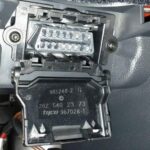BlueDriver stands out as a top contender for the best OBD2 reader in 2018. This review compares it to the generic ELM-327, highlighting BlueDriver’s superior functionality and compact design. We’ll delve into specific examples using a 2009 Honda CR-V and a 2005 Acura TSX, showcasing the depth of data BlueDriver provides.
BlueDriver’s Comprehensive Diagnostic Capabilities
Unlike basic OBD-II code readers, BlueDriver goes beyond surface-level diagnostics. It retrieves a comprehensive history of stored codes, offering valuable insights into a vehicle’s past issues. For instance, on a 2009 CR-V, BlueDriver unearthed a detailed record of past errors.
The report included a previously repaired wheel speed sensor issue and errors related to the rear right tire pressure monitoring system (TPMS), indicating low battery and lost transmission. BlueDriver’s ability to access TPMS codes demonstrates its advanced functionality.
BlueDriver vs. ELM-327: A Clear Winner
Compared to the generic ELM-327, BlueDriver provides significantly more detailed information. Its smaller size makes it even more convenient for road trips or used car inspections. While it may not support all vehicle models, such as the ABS codes on a 2004 Honda Civic, BlueDriver’s continuous app and firmware updates promise expanding vehicle and code support. This commitment to improvement reinforces its position as a leading OBD2 scanner.
In conclusion, BlueDriver’s comprehensive diagnostics, user-friendly interface, compact design, and continuous updates make it a strong contender for the best OBD2 reader of 2018. Its ability to access a wider range of codes, including TPMS data, sets it apart from generic OBD2 scanners, providing a more thorough understanding of a vehicle’s health.
